
Home
Services
About us
Blog
Contacts
Custom Mobile App Development for Smart Coffee Machines: How to Stand Out in the Smart Kitchen Market
1. Introduction: The Rise of Smart Coffee Culture
2. Why Coffee Machines Need Custom Mobile Apps
3. Key Features of a Smart Coffee Machine App
4. Technical Architecture & Development Process
5. Challenges and Solutions in Developing Coffee Tech Apps
6. Why A-Bots.com Is the Right Choice for Coffee Tech Projects
7. Conclusion: The Future Is Brewed with Code
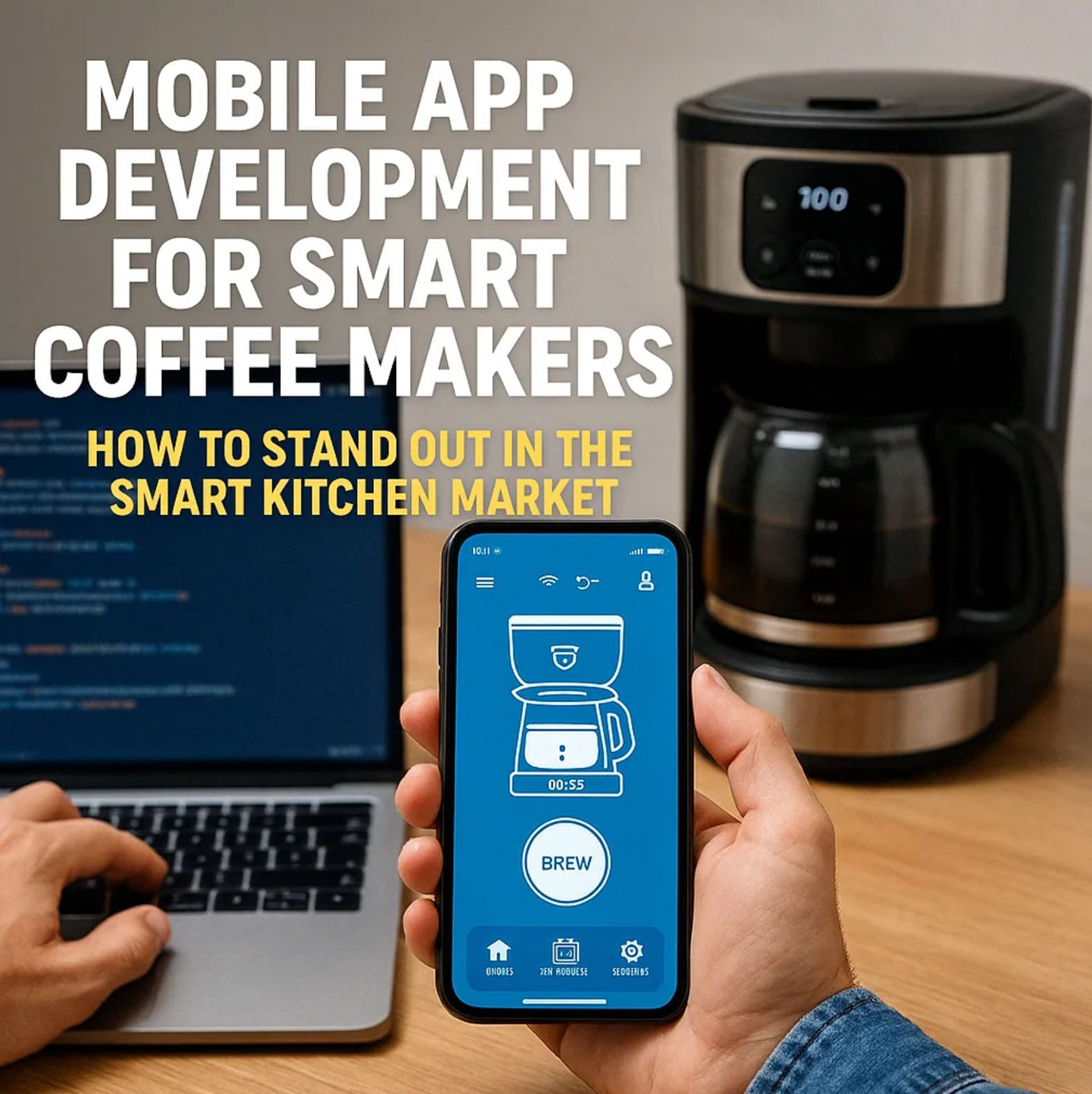
1. Introduction: The Rise of Smart Coffee Culture
When you walk into a modern kitchen today — whether in Manhattan, Sydney, or Stockholm — chances are, it’s no longer just about countertops and stainless steel. It’s about experiences, automations, and technology that understands you. And in the heart of this transformation sits an unassuming, yet profoundly influential device: the coffee machine.
But not just any coffee machine. The smart coffee machine — a new category of appliances redefining how people interact with their daily rituals. Once a mechanical device humming quietly in the background, the modern coffee maker now talks to your phone, listens to your commands, and even reminds you to descale itself.
“We no longer just brew coffee — we orchestrate personalized experiences, one cup at a time.”
☕ From Barista to Algorithm: The Digitalization of Coffee
According to Mordor Intelligence, the global coffee machine market is projected to reach $8.15 billion by 2029, driven significantly by demand for smart, connected features. Consumers today aren’t just buying appliances — they’re buying convenience, personalization, and connectivity.
In the United States alone, over 80% of households consume coffee daily, and with mobile device usage reaching 97% among working-age adults, the appetite for remote control, automation, and smart recipes is not a luxury — it’s an expectation.
This shift is not limited to consumer homes. Hospitality chains, co-working spaces, and even high-end offices are embracing connected coffee machines that allow employees to pre-program orders, monitor usage analytics, and reduce downtime via mobile alerts.
📲 Why Coffee Needs an App (and Not Just Any App)
The most well-known smart coffee machine brands — De’Longhi, Nivona, Jura, Krups — already offer mobile apps. But if you’ve ever used one, you’ll know they range from underwhelming to downright frustrating. Why? Because most of them are designed to be universal. They prioritize compatibility over experience.
That’s where custom app development enters the picture.
Imagine a coffee machine tailored for a premium co-working chain in San Francisco: the app could offer personal profile storage, multi-device login, and even integrate with building access systems. Or consider a boutique hotel in Amsterdam that wants to offer guests in-room coffee experiences managed through the main hotel app. A custom solution becomes not only viable — it becomes a competitive differentiator.
“Smart appliances aren’t smart unless the software behind them understands the user.”
In this world, off-the-shelf apps fall short. They don’t serve businesses that want more than basic functionality. They don’t understand workflows. They don’t deliver data that matters to operations or marketing teams.
🔍 Smart Coffee Is a Growing Niche — and Still an Open Race
The fascinating part? The "smart kitchen" is still in its early innings. Only 18–22% of households in North America have adopted more than one smart kitchen appliance, meaning that the space is ripe for innovation and brand loyalty.
Moreover, mobile app development for smart coffee machines is far from saturated. There’s no Starbucks of this market. No Apple. It’s a race open to hardware makers, hospitality brands, smart home platforms, and even startup disruptors.
And that’s where companies like A-Bots.com come in — not to build generic solutions, but to craft digital experiences that transform how people brew, connect, and enjoy coffee.
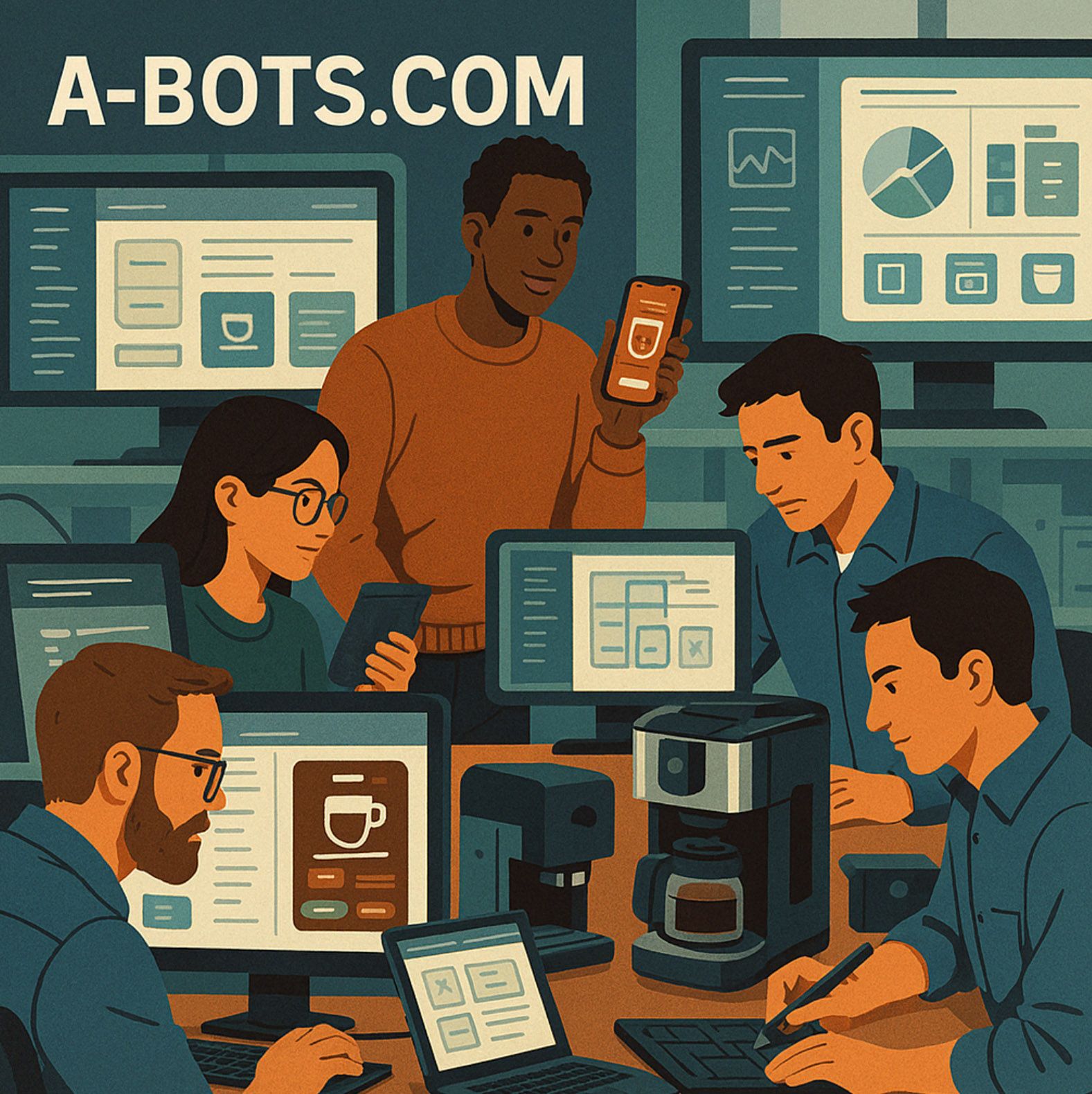
2. Why Coffee Machines Need Custom Mobile Apps
In the age of hyper-personalization, a coffee machine that merely brews your beverage is no longer enough. Today’s users — whether they’re tech-savvy millennials in a Brooklyn loft or hotel guests in Singapore — expect their devices to adapt to them. They want their machines to know their favorite brew strength, schedule a morning espresso before they even get out of bed, and sync seamlessly with their mobile ecosystem.
And yet, when it comes to mobile interfaces for smart coffee machines, most manufacturers still rely on generic, underperforming companion apps. These apps are often poorly maintained, clunky in UX, and riddled with connectivity issues. They may function, but they don’t delight — and they rarely add value beyond the basic “start brew” command.
That’s why custom mobile apps are no longer a nice-to-have — they’re a strategic necessity.
⚙️ Generic Apps Don't Understand Your Business
Most off-the-shelf coffee machine apps are built with mass-market consumers in mind. They’re designed to be compatible across a broad range of devices, sacrificing tailored features in favor of universality. For individual households, that might be acceptable. For businesses? It’s a bottleneck.
Consider a boutique coffee roaster in Austin that wants its machines to track bean origin, grind freshness, and offer tasting notes via app. Or a luxury office in London that wants employees to order drinks via mobile and track consumption for sustainability reports. No generic app will cover that.
"Mass-market apps are built for users. Custom apps are built for brands."
This becomes even more critical when hardware manufacturers want to build long-term brand loyalty. A beautifully designed, intuitive, and deeply integrated app is what keeps a user coming back — not the boiler pressure or cup tray material.
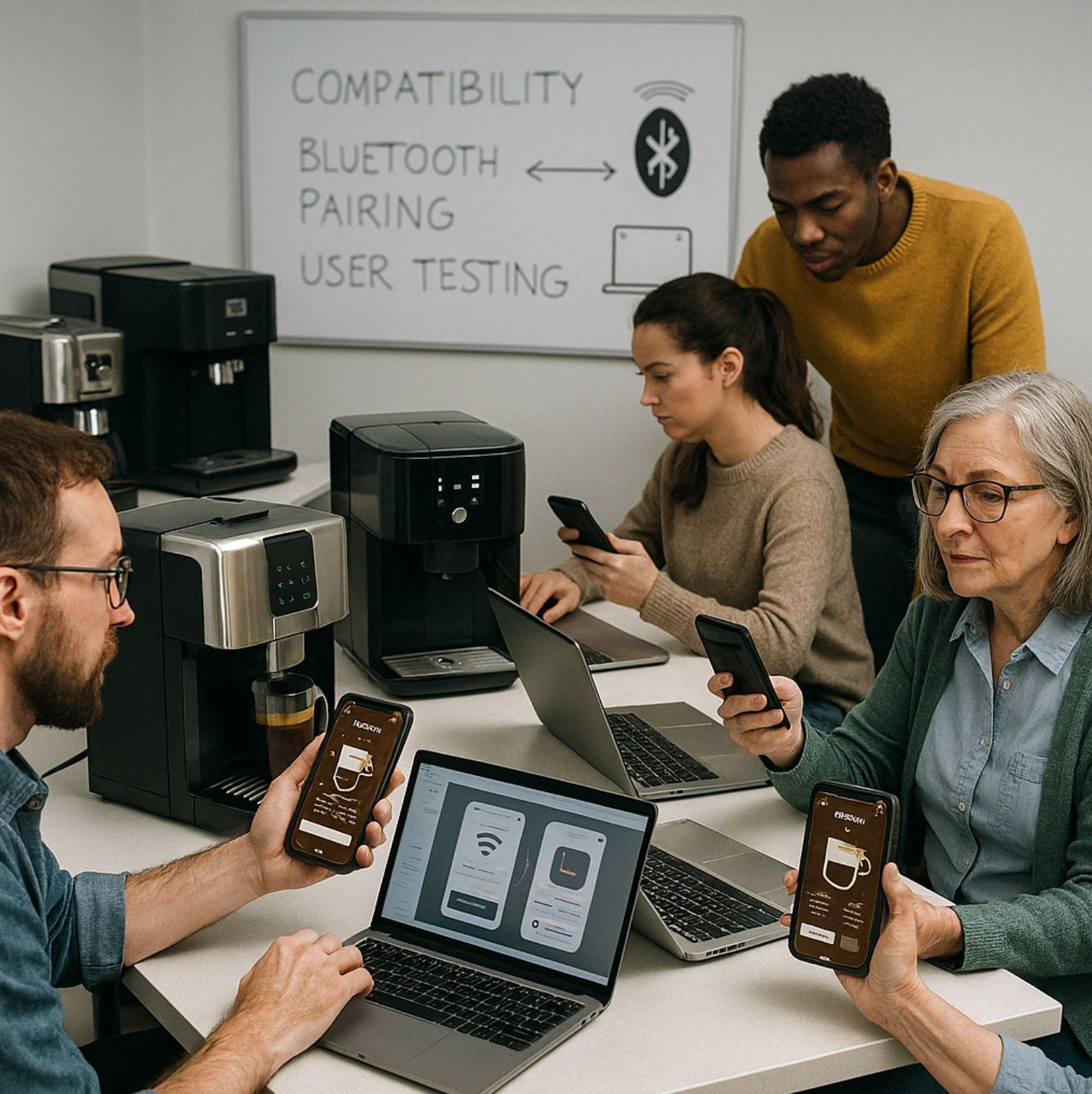
📉 The Hidden Costs of Generic Solutions
Let’s talk numbers. A 2023 survey by Statista showed that 38% of smart appliance users have abandoned or stopped using the default manufacturer app within three months due to poor performance, limited functionality, or bad UX.
Worse still, companies lose data — valuable behavioral data that could help optimize marketing, maintenance schedules, or product design — because generic apps don’t offer detailed analytics dashboards or custom backend integration.
Additionally, white-labeled or OEM apps often suffer from:
- Brand inconsistency — Logos, tone, and UI don’t match the physical product.
- Lack of updates — Once released, many apps aren’t maintained.
- Low interoperability — Poor integration with smart home ecosystems like Alexa, HomeKit, or SmartThings.
In contrast, a custom app can directly support your roadmap. Want to integrate a subscription-based coffee delivery system? Need QR-based access for hotel guests? Planning to launch a loyalty rewards program? A custom app scales with your vision.
☕ Real Use Cases That Call for Customization
Let’s look at the real world:
- Coffee chains and cafés want to synchronize apps with POS systems, push loyalty points, allow mobile pre-ordering, and send out promotional push notifications.
- Hospitality providers look for seamless integration with room automation systems, personalization per guest, multilingual interfaces, and AI-powered beverage recommendations.
- Hardware manufacturers (OEMs and startups alike) often want to A/B test different brew profiles, track user interaction data, and provide OTA firmware updates via the app itself.
None of this is possible with a basic app that just mimics physical buttons.
🧠 Your App Is Not Just a Remote — It's a Platform
When done right, a custom mobile app for a coffee machine becomes more than a remote control — it becomes an extension of the brand, a customer loyalty engine, a data source, and a digital service channel.
You can unlock real differentiation:
- Real-time brew diagnostics
- Personalized flavor recommendations based on past behavior
- Integration with coffee bean suppliers
- Gamification: “Brew streaks,” “coffee badges,” etc.
- Seasonal drink releases via software
In other words, you're building a connected coffee experience, not just a brew button on a screen.
“In the future, coffee makers will be less about boiling water — and more about boiling data to brew better business decisions.”
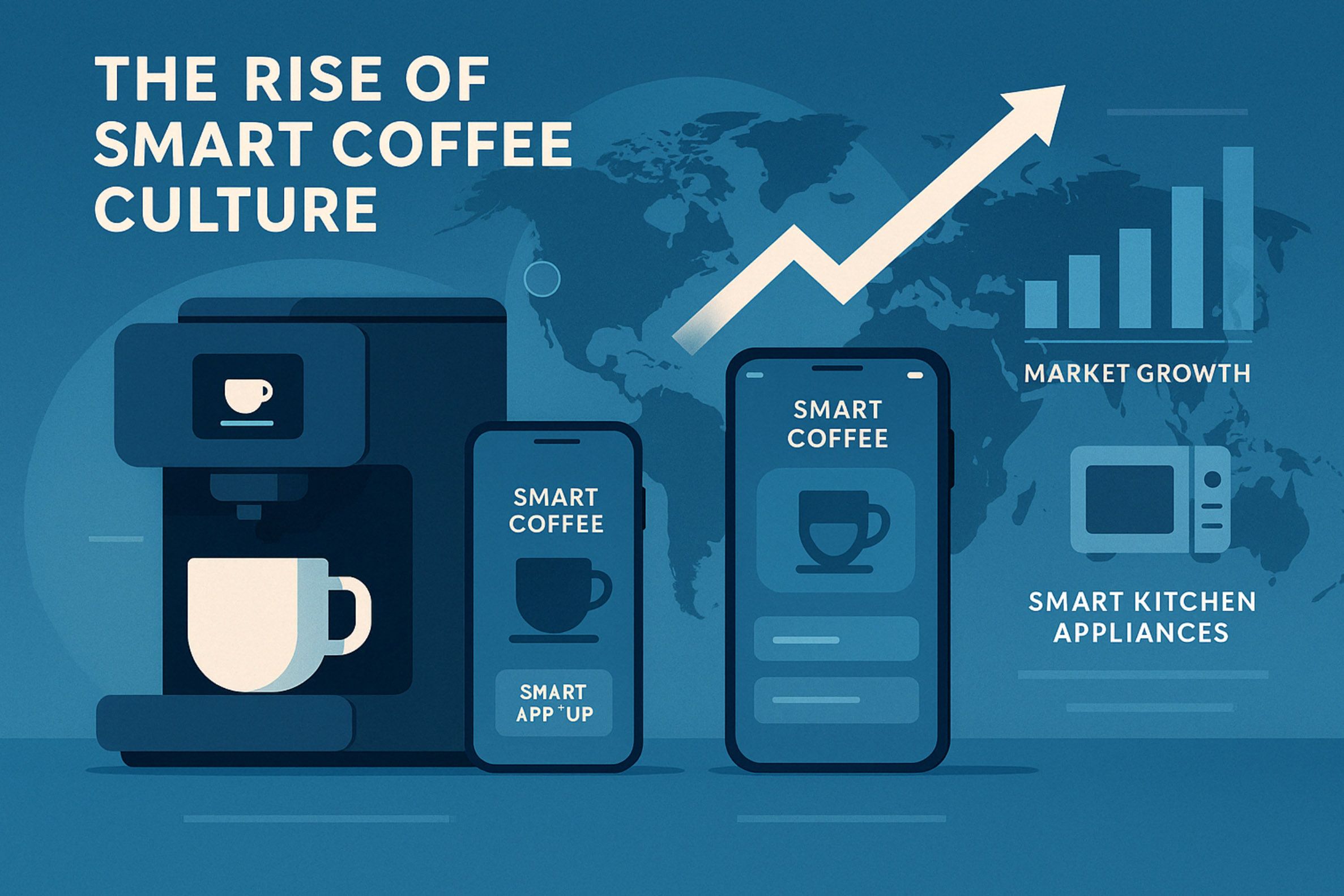
3. Key Features of a Smart Coffee Machine App
Designing a smart coffee machine app isn’t about replicating the physical interface on a digital screen. That’s a common mistake — and one that significantly limits user engagement. A truly effective app must not only offer functionality but extend the capabilities of the hardware, making it more intelligent, personalized, and tightly integrated into users’ digital lifestyles.
The architecture of a custom app for a coffee machine typically begins with device pairing and communication. Whether via Bluetooth, Wi-Fi, or a hybrid model, the connection must be seamless, reliable, and secure. This is the backbone. Once connectivity is ensured, the possibilities multiply.
The most fundamental feature — brewing control — must be instantaneous and granular. Users expect to choose drink types, customize strength, temperature, milk ratios, or foam density, and store these preferences. But this is only the surface. What elevates a coffee app into a smart application is how it handles behavior over time. For example, does it recognize that the user prefers strong espresso early in the week and lighter brews on weekends? Can it anticipate a double-shot request after calendar events tagged "early meeting"?
To deliver this level of insight, data collection modules must be embedded deeply. Every button press, brew adjustment, or delay becomes a learning signal. This requires a backend capable of tracking and processing user profiles, securely storing them in the cloud, and feeding them back to the app and machine. With this infrastructure, features like “suggested brew of the day” or “smart refills” become not only possible but reliable.
Another key component is remote access. For users who are not physically near the device — think of a business lounge where the app queues orders for travelers or a remote-start espresso while a user is still in bed — the application must manage asynchronous commands. That means designing APIs that handle device status polling, error resolution, and order confirmation across networks with different latency and reliability. Here, a basic embedded firmware won’t suffice. The app has to include state synchronization logic, fallback routines, and predictive diagnostics.
Security, often overlooked in the IoT appliance world, becomes a central concern when dealing with user identities, payments, and consumption data. Integration with Apple or Google login, biometric authentication, and encrypted communication channels are no longer optional. For multi-user environments, such as co-working spaces or shared apartments, the app must support differentiated roles and permissions — a user hierarchy, if you will, where certain features are locked or prioritized based on status or preference.
One of the most complex yet powerful aspects is firmware management. In well-designed ecosystems, the app can act as a delivery channel for firmware updates, pushing patches or feature upgrades wirelessly. This requires tightly coupled coordination between mobile development and embedded systems engineering — and a dashboard interface for operators to manage and trigger these updates.
Another layer involves supply chain integration. Users expect to know when their beans are low, and businesses want predictive models to avoid service disruption. Integrating the app with stock management platforms — even enabling automatic ordering from partner roasters — adds true operational intelligence.
In business contexts, such as boutique hotels or premium office spaces, the application often extends further. Analytics dashboards showing usage patterns, machine uptime, top brew types, or even customer satisfaction based on app feedback are becoming essential. This transforms the app into an operational tool for managers, not just a remote for users.
Lastly, there is the emotional aspect. A coffee machine app, when designed properly, doesn't just make coffee — it builds habit, routine, and brand intimacy. A welcome message in the morning. A reminder to try a new seasonal roast. A little note on International Coffee Day. These micro-moments, while technically simple, are strategically powerful.
A custom coffee machine app is, ultimately, a fusion of control, insight, personalization, and brand narrative — delivered through a touchscreen. And while many manufacturers still treat apps as an accessory, the smarter ones understand: the app is the product.
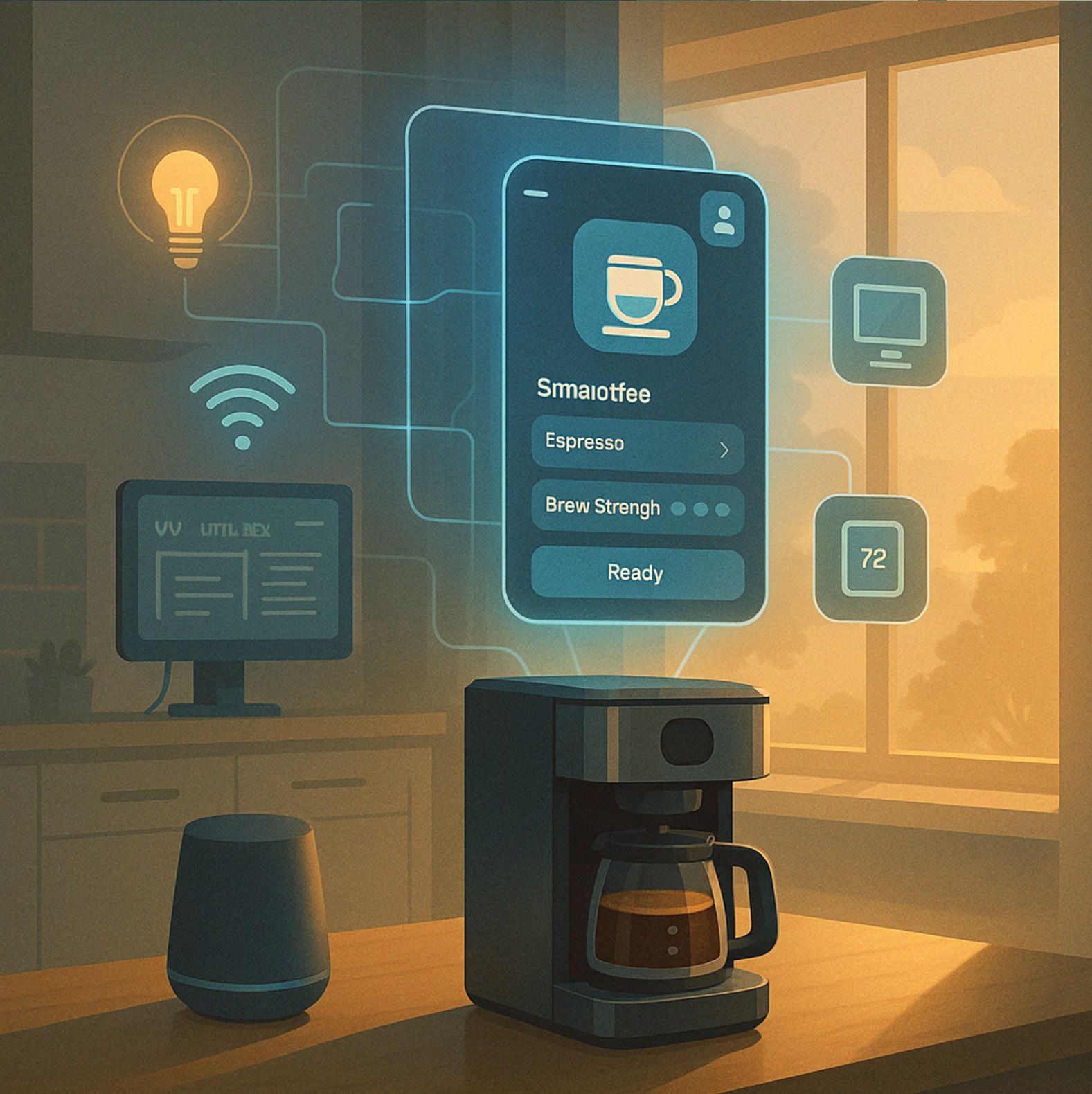
4. Technical Architecture & Development Process
Developing a custom mobile app for a smart coffee machine is not just about pushing buttons from a phone — it's about engineering a reliable, secure, and scalable system that bridges hardware and user behavior through digital interfaces. The process is multi-layered, demanding deep integration between embedded systems, cloud services, and mobile software.
At the foundation lies the communication protocol between the machine and the mobile app. Depending on the use case and connectivity environment, this may rely on BLE (Bluetooth Low Energy) for local pairing, Wi-Fi for broader control and firmware updates, or even hybrid setups that switch based on signal strength and network availability. At A-Bots.com, we typically implement custom protocol handlers with fallback logic, ensuring operations can still complete if the primary channel fails.
The architecture itself consists of four main layers:
1. Embedded Firmware (on the coffee machine)
The firmware acts as the local OS for the coffee machine. It exposes an interface — often via UART or I²C — to control modules such as water temperature sensors, pressure regulators, motorized milk frothers, and heating coils. This is where precise timing and real-time operations matter most.
Our team works closely with the hardware designers to define a modular API layer that the mobile app will ultimately call. All commands (e.g., brewEspresso(size, strength, milkFoam)) are built atop this layer. Crucially, we ensure the firmware is OTA-upgradable through a secure bootloader, so we can deploy fixes and enhancements long after the device is sold.
2. Mobile App Layer (iOS, Android)
On the mobile side, we develop native applications using Swift and Kotlin, or cross-platform apps using Flutter, depending on performance and timeline requirements. The app handles:
- Real-time UI feedback with command acknowledgement
- Local/remote mode detection
- Secure onboarding (QR or NFC)
- Profile sync (user preferences, scheduled brews)
- Localization, accessibility, and theme customization
A key challenge here is managing state consistency — especially when a user interacts with the app while the machine is offline or in mid-operation. We use state machines and error queues to ensure commands are executed or retracted properly.
For example, if a user sends a brew request but then modifies parameters mid-operation, our system ensures graceful rollback or update, preventing firmware hangups or inconsistent behavior.
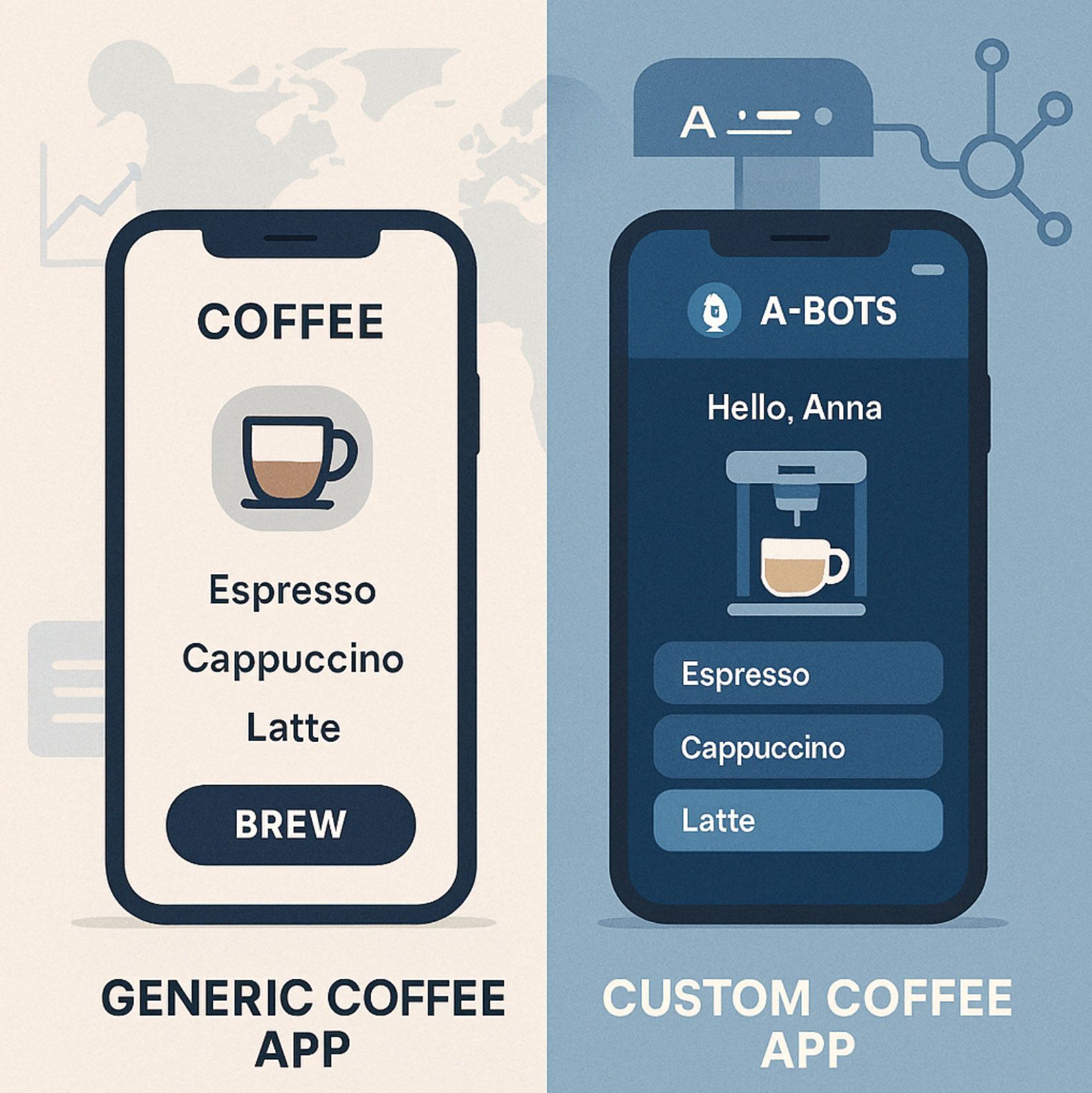
3. Cloud Infrastructure
For machines with Wi-Fi and account features, we deploy a scalable backend — typically using AWS (Lambda, IoT Core, DynamoDB, S3) or Google Cloud Platform (Cloud Functions, Firebase).
Key backend features include:
- Authentication and session management (OAuth2, JWT)
- Device registry: mapping physical machines to user accounts
- Telemetry ingestion: temperature curves, failure logs, brew counts
- Command broker: sending commands from mobile to device via MQTT or HTTPS
- Usage analytics: dashboards for business intelligence
- Edge caching for remote operations under poor connectivity
This infrastructure also enables multi-device management, essential for offices or hospitality clients managing fleets of machines.
4. Security Stack
Security is non-negotiable. From the moment a user connects to a coffee machine, to when they adjust water hardness settings or store payment methods for bean reordering — data must be encrypted, authenticated, and compliant.
Security implementations include:
- AES-256 for data transmission
- TLS 1.3 for mobile-to-cloud and cloud-to-device comms
- mTLS (mutual TLS) for IoT device validation
- OAuth2 with refresh tokens for session management
- Role-based access control (admin, guest, technician)
- GDPR and CCPA compliance options for user data control
We also deploy threat monitoring tools on the cloud infrastructure, and leverage CI/CD pipelines with automated security scans (e.g., Snyk, SonarQube) to maintain code hygiene.
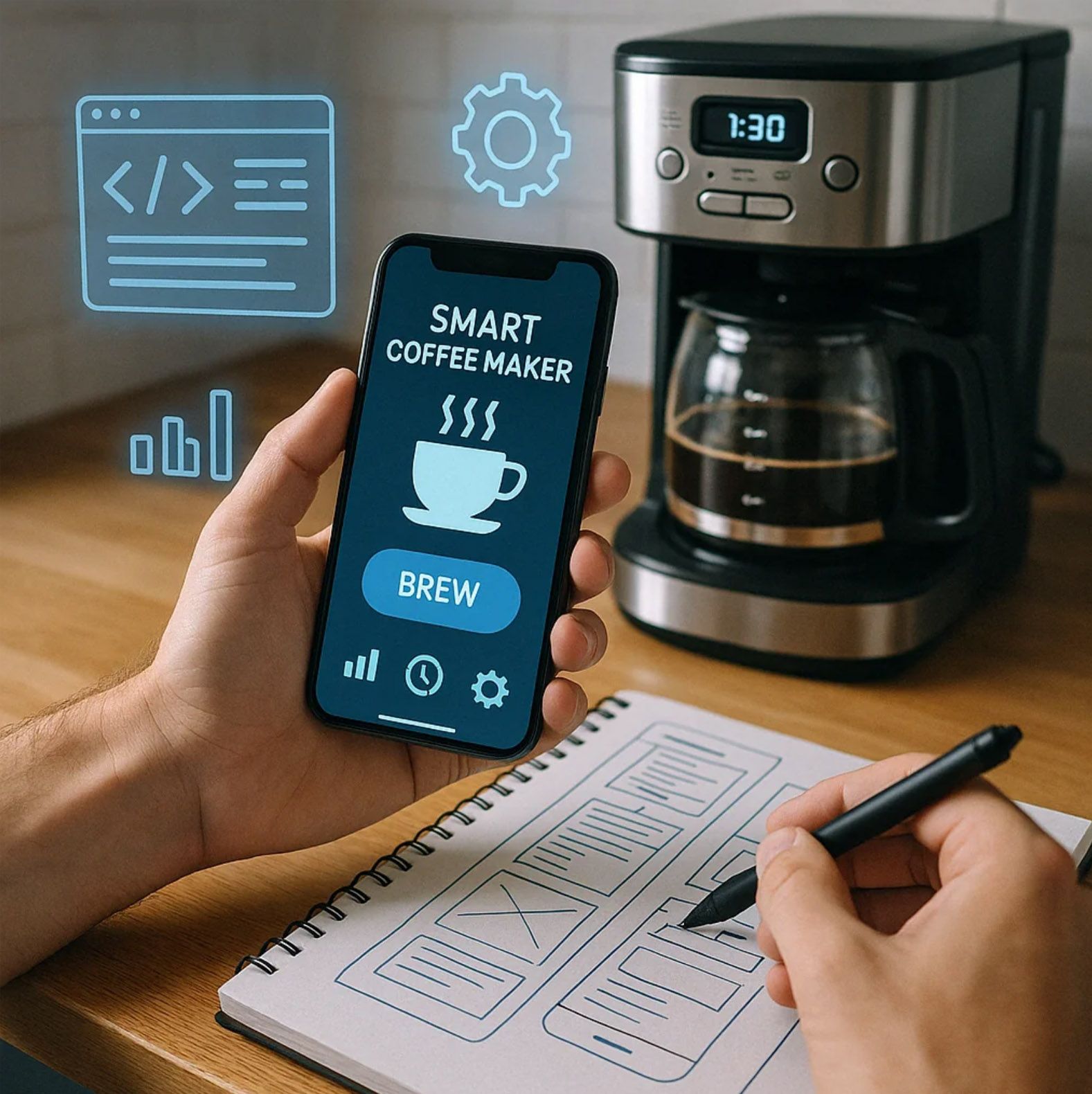
The A-Bots.com Approach to Development
Our process typically follows a hybrid Agile methodology tailored to IoT projects, which include both hardware and software dependencies. A typical project runs as follows:
-
Discovery Phase
- Technical analysis of coffee hardware capabilities
- Stakeholder interviews
- UX prototyping (Figma, InVision)
- Definition of communication protocols
-
MVP Engineering
- Base firmware + core mobile features
- Secure device pairing and control
- Initial cloud setup and test environment
-
Iteration & Expansion
- Added personalization, scheduling, statistics
- Multi-device management and user profiles
- Push notifications, error reporting, OTA firmware
-
Testing and Compliance
- Unit, integration, field tests with real machines
- FCC, CE, RoHS prep (if hardware needs certs)
- Penetration testing (especially for B2B solutions)
-
Deployment
- App Store / Google Play release with ASO
- Launch support, onboarding flows
- Maintenance, monitoring, SLA contracts
Our internal tools include Dockerized test benches for simulating hundreds of machine states, automated QA suites, and remote log analyzers embedded in apps for efficient debugging.
A coffee machine is a precise piece of engineering. The software that controls it must be no less precise — and far more flexible. At A-Bots.com, we design systems that don't just enable machines to connect — we enable them to learn, adapt, and delight.
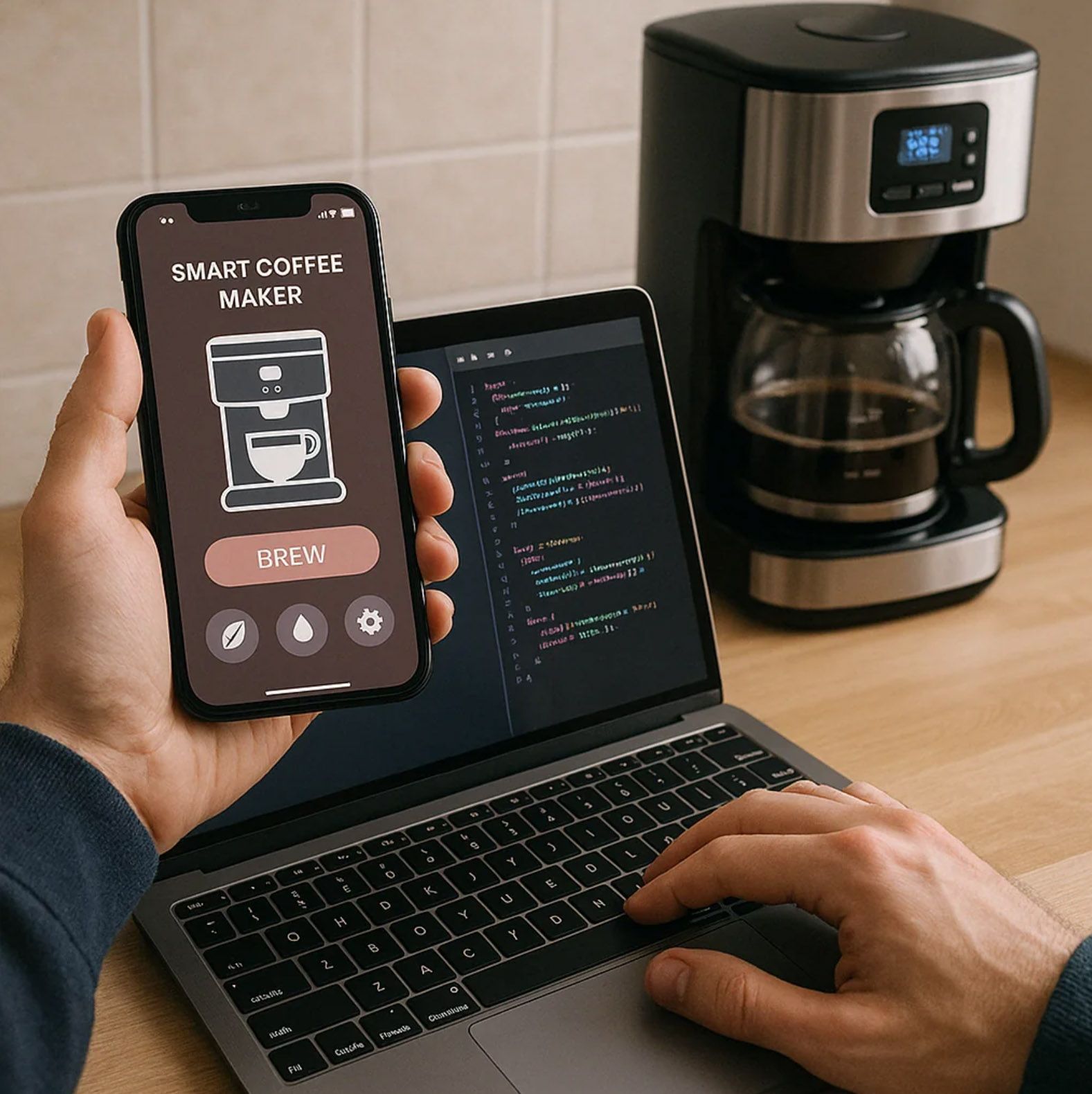
5. Challenges and Solutions in Developing Coffee Tech Apps
Creating a mobile app for a smart coffee machine might seem like a straightforward task — connect, send a command, brew a cup. But anyone who has worked on smart appliance integration knows: the moment real hardware enters the loop, the complexity escalates. You’re not just designing an app — you’re designing a reliable user experience across software, hardware, and physical interaction. Let’s explore the most pressing challenges and the engineering solutions we implement at A-Bots.com.
Bridging the Gap Between Hardware Timing and Software Expectations
Coffee machines operate on mechanical processes — heating water, grinding beans, frothing milk. These take time and are subject to physical variability (like water pressure or ambient temperature). But mobile app users expect real-time feedback and responsive controls.
One of the toughest challenges is synchronizing UI feedback with hardware state. For example, if a user taps “Latte” and expects milk frothing to start in 3 seconds, but due to heating delays it takes 9 seconds, they might think the app or machine is broken.
Our solution involves implementing state caching and progress estimation algorithms. By learning from historical machine behavior (e.g. how long it usually takes to heat water from 20°C to 93°C), the app can display estimated progress in real-time. Even if the command hasn’t completed, the UI gives a sense of momentum — reducing frustration.
Handling Connectivity Dropouts Gracefully
Many smart coffee machines use BLE or Wi-Fi. But what happens when a user walks out of range mid-brew? Or the machine disconnects from the router during a scheduled brew?
We’ve seen situations where a lost connection caused a command to be resent multiple times — resulting in an overflowed cup, or worse, internal system lock-ups.
To mitigate this, A-Bots.com implements:
- Command queueing with transactional IDs: Each command has a unique ID and confirmation handshake.
- Redundancy timers that check for completion before retrying.
- Local fallback logic: If Wi-Fi is lost, the machine can continue the task autonomously.
These systems require close coordination between embedded engineers and mobile developers — something our integrated team is well-equipped to handle.
Designing for Multiple User Profiles & Environments
Home users, hotel guests, baristas — all have different needs. A single household might have several users with vastly different coffee preferences. In contrast, a boutique hotel may need a simplified UI with minimal options and daily reset behavior.
This presents a challenge: how do you design one application flexible enough to meet these diverse scenarios without overwhelming the user?
At A-Bots.com, we develop role-based UI logic. Based on user type, the app dynamically adjusts:
- Menu complexity
- Available brew options
- Scheduling permissions
- Logging depth
Moreover, we offer cloud-based configuration for B2B clients to remotely set defaults per machine — ideal for franchises and hospitality settings.
Security vs. Usability: A Delicate Balance
Security is critical — especially when apps store personal brew preferences, payment options, or location data. But it can’t come at the cost of convenience. Forcing two-factor authentication every time someone wants a cappuccino is, well, bad design.
So, we implement contextual security measures:
- Biometric unlock for payment and profile changes
- Token refresh timers based on risk score (e.g., new device = more secure prompt)
- Encrypted local storage with optional remote wipe
This way, end users enjoy a frictionless experience while the system remains protected behind modern security protocols like AES, TLS 1.3, and OAuth2.
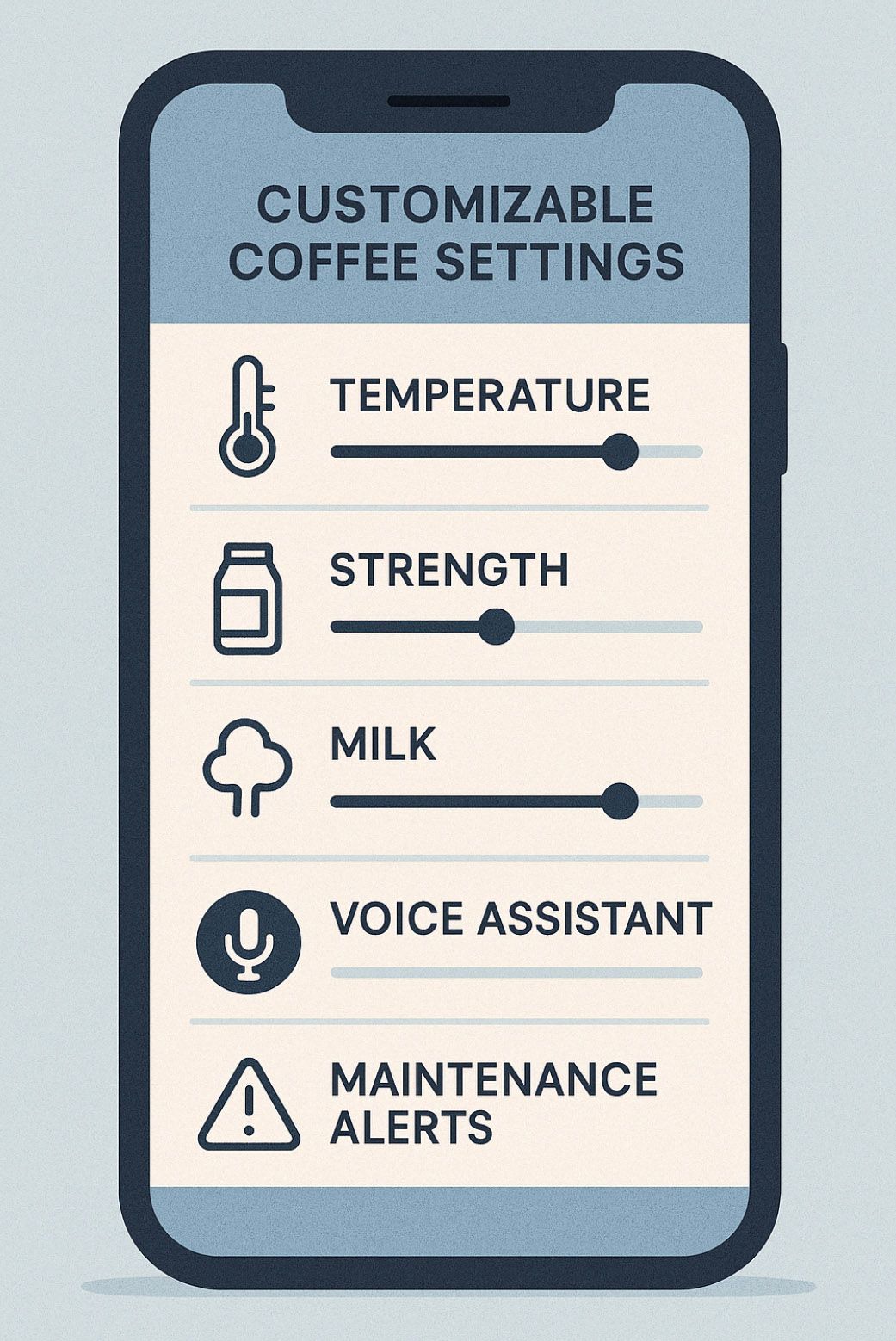
Supporting OTA Firmware Without Bricking Machines
Over-the-air updates are a must — to fix bugs, add features, or update protocols. But pushing new firmware to a physical appliance carries real risk: one broken update could brick a machine, leaving hundreds of users without their morning coffee.
To avoid catastrophe, we use:
- Dual-partition firmware: One for active, one for update. Only switch once the new firmware passes self-check.
- Rolling deployments: Push updates in small batches, monitor for anomalies.
- User deferral options: Let users postpone updates until after morning rush.
Combined with robust telemetry and remote logging, this ensures safe, controlled firmware evolution over time.
Making the Invisible Visible: UX for Physical Systems
One of the subtle yet profound challenges in smart coffee UX is the fact that users don’t see what’s happening inside the machine. There’s no visual cue for "water is heating" or "pump is stuck". Without these signals, users blame the app — or worse, themselves.
We combat this by:
- Visualizing internal states: animated diagrams of machine parts in action
- Contextual alerts: "Water tank low" vs. generic "Something went wrong"
- User education: onboarding screens that explain what to expect during brewing
These design choices dramatically reduce customer support calls and improve perceived reliability.
At A-Bots.com, we don’t just build pretty interfaces — we solve problems at the intersection of engineering, user psychology, and physical limitations. Every tap in the app must result in predictable, delightful, and safe behavior from the machine. And that only happens when the development team sees the whole system — not just the screen.
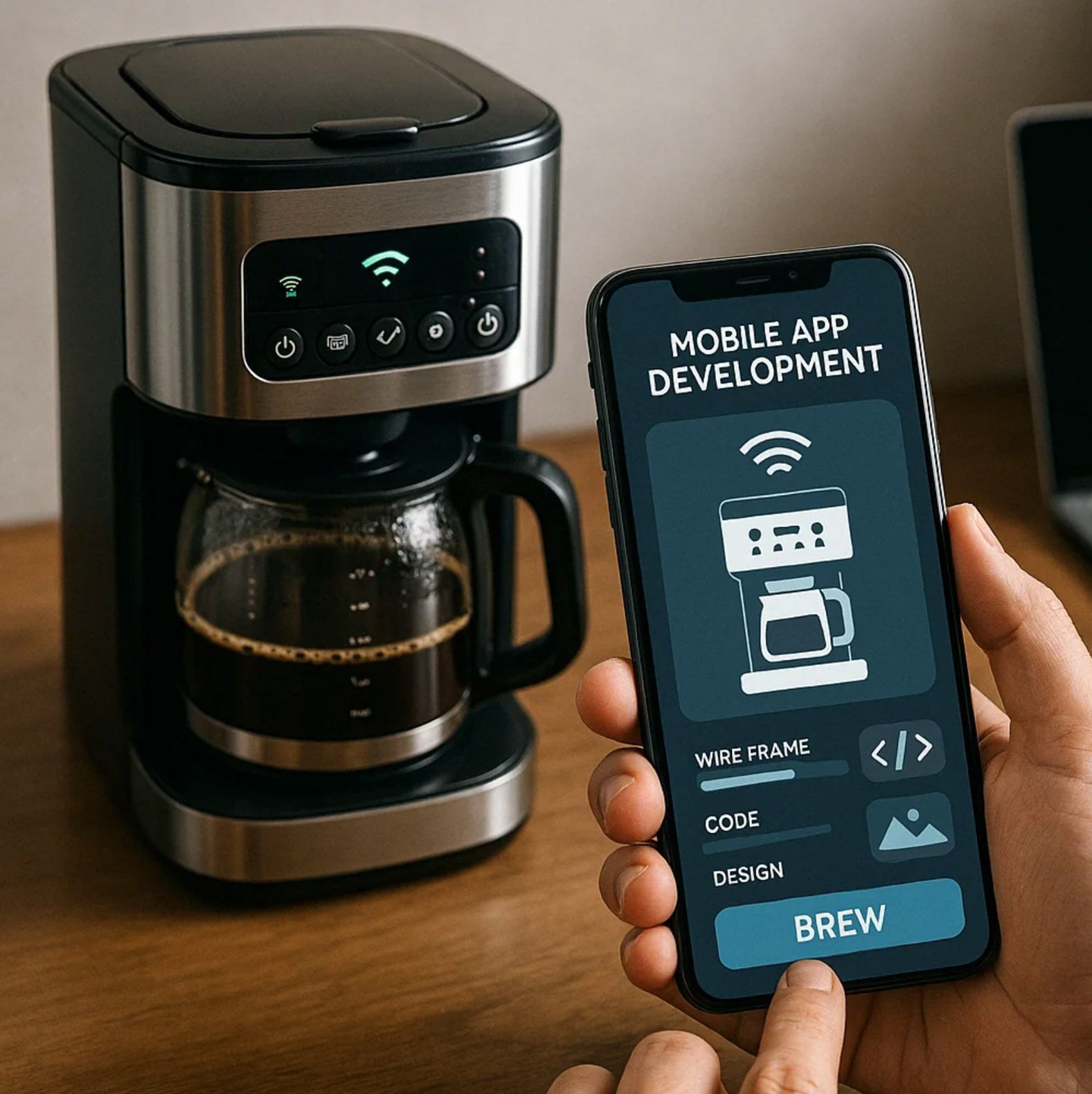
6. Why A-Bots.com Is the Right Choice for Coffee Tech Projects
In the age of smart appliances, the difference between a decent coffee experience and a delightful one often lies in the software that powers it. A beautiful cup of coffee is chemistry, timing, heat, and pressure — but the software orchestrating that behind the scenes must be just as precise. That’s where A-Bots.com comes in.
We’re not just a mobile app development company. We’re an engineering-driven, detail-obsessed, IoT-smart team that thrives on building digital ecosystems around physical products. And when it comes to coffee technology, we’re already one step ahead — because we've done it.
A-Bots.com has hands-on experience in designing and delivering mobile apps for connected home appliances. One of our most notable projects involved building a smartphone control system for a leading coffee machine brand, integrating features like remote brew scheduling, water level monitoring, and even user-preferred recipe storage. But we didn’t stop there — we also developed internal tools for the manufacturer to collect device performance analytics, track user engagement, and push OTA firmware updates seamlessly.
What makes us different is not just technical fluency — it’s contextual awareness. We understand the unique nuances of coffee culture, whether you’re building for American households, Scandinavian precision drinkers, or Australian espresso purists. Our UX/UI design choices are always informed by this understanding. For example, when we worked on a prototype for a smart espresso app, we made sure that the tactile feel of adjusting grind size and temperature on the app’s interface matched the elegance and control of the physical machine. Subtle, but powerful.
Another core strength? We speak the language of hardware integration. From BLE protocols and MQTT messaging to integrating with embedded firmware and controlling heating elements — our developers know how to bridge mobile apps and machine logic. And that matters when the goal is to build a robust, responsive coffee experience.
We’ve also collaborated with Shark Robotics to create the control interface for their line of autonomous vacuums — which, like coffee machines, required device discovery, connection protocols, session management, and real-time command execution. These parallels give us a strong foundation for any smart appliance — and allow us to work faster, safer, and more creatively.
And while we’re based in the digital space, we work with clients around the globe — U.S., EU, U.K., Australia, and beyond. Custom Coffee Machine Mobile App Development from A-Bots.com. We know how to design with data privacy regulations like GDPR and California's CCPA in mind, and we understand the importance of compliance, accessibility, and long-term maintainability.
We also take post-launch support seriously. Our clients don’t just get an app — they get a partner. That means versioning, user analytics dashboards, cloud hosting, OTA firmware support, and timely upgrades whenever the machine or mobile OS changes.
Ultimately, what we offer is not just software — it’s a digital layer of your brand. And for coffee manufacturers, that’s crucial. In a crowded marketplace, user experience is a differentiator, and A-Bots.com ensures that your machine doesn’t just make great coffee — it feels like it was designed specifically for your customer, on their terms.
So, if you’re ready to transform your coffee machine into a smart ecosystem — get in touch. We’ll brew the future together.
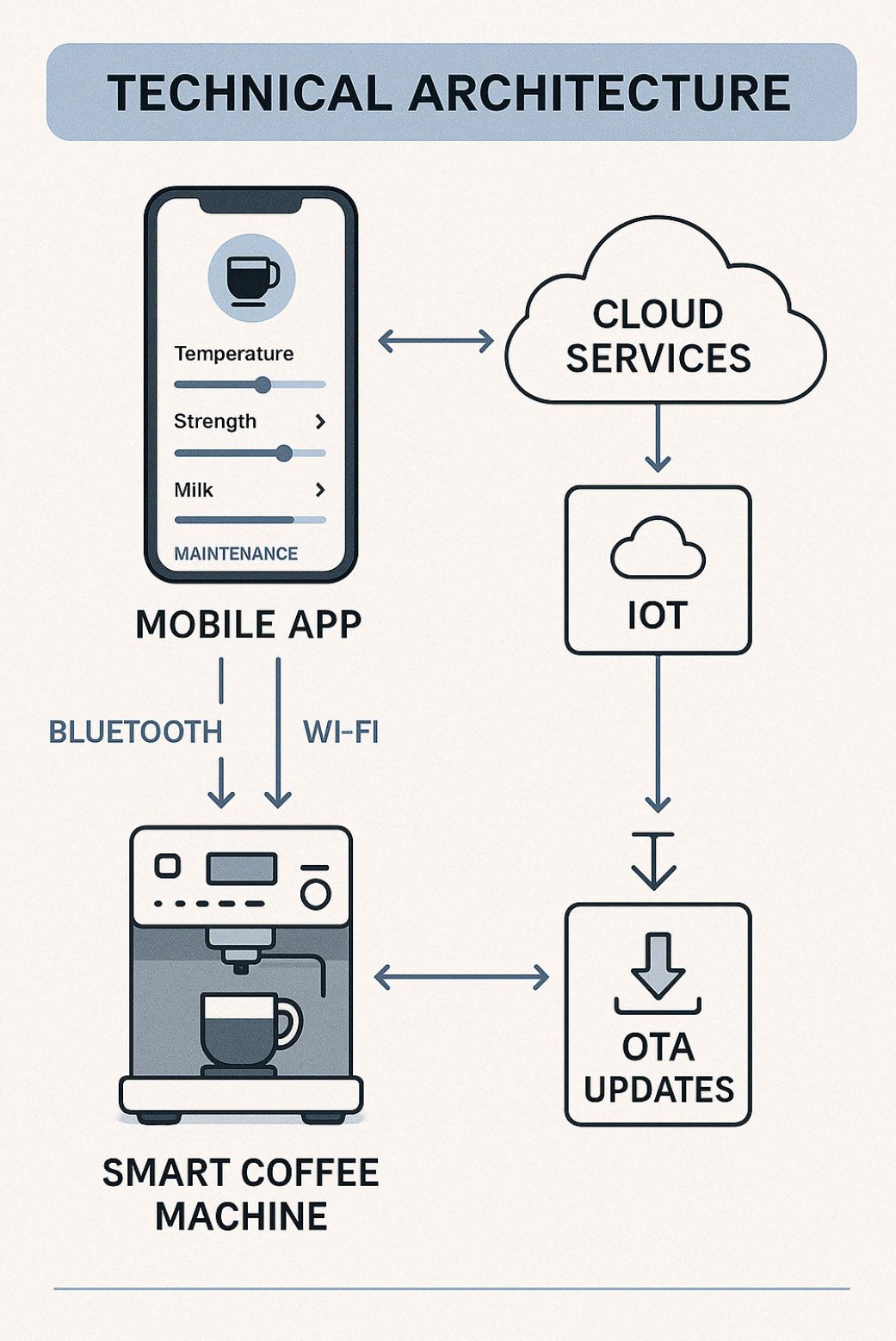
7. Conclusion: The Future Is Brewed with Code
Coffee is more than a beverage. It’s a ritual, a rhythm, a personal moment in the day. And like everything meaningful, it deserves technology that understands it — not just controls it.
That’s why generic software isn’t enough.
A recent report from Grand View Research forecasts that the global smart coffee machine market will reach $11.6 billion by 2030, growing at a CAGR of 8.3%. Consumers are not just demanding quality brews — they expect personalization, automation, and intelligent integration with their digital lives.
But here’s the twist: while hardware innovation in coffee machines has surged, software innovation often lags behind. Many manufacturers stick with clunky apps, outdated interfaces, or worse — no app at all. It’s like serving third-wave, single-origin espresso in a paper cup. Technically fine, but emotionally disconnected.
Custom software development changes that. It transforms a coffee machine from a product into a personal barista, a brand ambassador, and a source of daily joy.
At A-Bots.com, we see every smart appliance as a story waiting to be told — in code. Just like a master roaster fine-tunes every batch, we fine-tune every screen, tap, and micro-interaction in your app to make sure it aligns with your brand, your users, and your machine’s unique capabilities.
The real beauty of a custom coffee app lies in its flexibility. Want to integrate voice controls via Alexa or Google Assistant? No problem. Want to log consumption data to suggest subscription refills? Already done it. Need to support Bluetooth LE, Wi-Fi, remote brew scheduling, and OTA firmware updates? We’ve built entire platforms around that.
And for those building coffee machines for commercial environments — hotels, cafés, offices — we understand the B2B angle too. Loyalty programs, fleet analytics, branded mobile experiences — we’ve helped businesses turn coffee into a competitive edge.
Let’s also not forget the numbers that matter to you: A custom app doesn’t just enhance UX. It drives repeat usage, reduces support costs, and unlocks product insights that improve hardware iterations. In some of our past projects, the average session length in custom apps was 45% longer than in stock software, and user retention after 30 days exceeded 62% — all because we focused on the intersection of experience + performance.
So, here’s the final shot:
☕ The next evolution of coffee culture won’t be brewed in a moka pot — it’ll be brewed in software.
Your coffee machine already has the tech.
Now it’s time to give it the app it deserves.
Let A-Bots.com help you build it.
Hashtags
#CoffeeTech
#SmartCoffeeMachines
#IoTDevelopment
#CustomAppDevelopment
#CoffeeMachineApp
#MobileAppForCoffee
#SmartHomeAppliances
#ConnectedCoffee
#CoffeeAppUX
#CoffeeMakers
#TechForBeverages
#ABotsDevelopment
Other articles
Custom CRM for Real Estate Developers Off-the-shelf CRM tools weren’t built for the complexity of real estate development — but we were. This in-depth article explores why custom CRM solutions are redefining how developers manage projects, leads, teams, and revenue. See real-world ROI calculations, key challenges, and expert insights from A-Bots.com, a top CRM development company.
Custom Agriculture App Development for Farmers In 2024, U.S. farmers are more connected than ever — with 82% using smartphones and 85% having internet access. This article explores how mobile applications are transforming everyday operations, from drone-guided field scouting to livestock health tracking and predictive equipment maintenance. It examines why off-the-shelf apps often fail to address specific farm needs and how collaborative, farmer-funded app development is gaining momentum. Through real-world examples and step-by-step guidance, readers will learn how communities of growers can fund, design, and launch custom apps that fit their exact workflows. A-Bots.com offers tailored development services that support both solo farmers and agricultural groups. With offline capabilities, modular design, and support for U.S. and international compliance, these apps grow alongside the farm. Whether you're planting soybeans in Iowa, raising cattle in Texas, or running a greenhouse in California — this article offers the tools and inspiration to build your own farm technology. Discover why more farmers are saying: we don’t wait for the future — we build it.
Custom Drone Mapping Software & Control Apps: Smarter Aerial Solutions by A-Bots.com Custom drone software is revolutionizing how industries operate—from precision agriculture to infrastructure inspection. This article explores why off-the-shelf apps fall short, how AI and modular design shape the future, and how A-Bots.com delivers tailored drone solutions that truly fit. Whether you manage crops, assets, or entire projects, the right software lifts your mission higher.
Custom IoT for Smart Greenhouses and Vertical Farms Modern greenhouses and vertical farms demand more than off-the-shelf solutions. In this article, discover how custom IoT systems — built around your space, your crops, and your team — can unlock new levels of efficiency, automation, and yield. Packed with real-world examples, insights from A-Bots.com engineers, and expert advice, this guide will inspire your next step in smart agriculture. If you're ready to grow smarter — start here.
Top stories
Copyright © Alpha Systems LTD All rights reserved.
Made with ❤️ by A-BOTS
